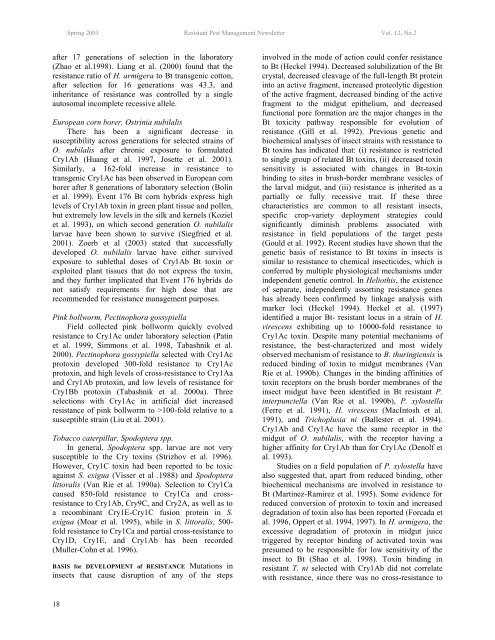Vol.12_No.2 - Pesticide Alternatives Lab - Michigan State University
Vol.12_No.2 - Pesticide Alternatives Lab - Michigan State University
Vol.12_No.2 - Pesticide Alternatives Lab - Michigan State University
Create successful ePaper yourself
Turn your PDF publications into a flip-book with our unique Google optimized e-Paper software.
Spring 2003 Resistant Pest Management Newsletter Vol. 12, <strong>No.2</strong>after 17 generations of selection in the laboratory(Zhao et al.1998). Liang et al. (2000) found that theresistance ratio of H. armigera to Bt transgenic cotton,after selection for 16 generations was 43.3, andinheritance of resistance was controlled by a singleautosomal incomplete recessive allele.European corn borer, Ostrinia nubilalisThere has been a significant decrease insusceptibility across generations for selected strains ofO. nubilalis after chronic exposure to formulatedCry1Ab (Huang et al. 1997, Josette et al. 2001).Similarly, a 162-fold increase in resistance totransgenic Cry1Ac has been observed in European cornborer after 8 generations of laboratory selection (Bolinet al. 1999). Event 176 Bt corn hybrids express highlevels of Cry1Ab toxin in green plant tissue and pollen,but extremely low levels in the silk and kernels (Kozielet al. 1993), on which second generation O. nubilalislarvae have been shown to survive (Siegfried et al.2001). Zoerb et al (2003) stated that successfullydeveloped O. nubilalis larvae have either survivedexposure to sublethal doses of Cry1Ab Bt toxin orexploited plant tissues that do not express the toxin,and they further implicated that Event 176 hybrids donot satisfy requirements for high dose that arerecommended for resistance management purposes.Pink bollworm, Pectinophora gossypiellaField collected pink bollworm quickly evolvedresistance to Cry1Ac under laboratory selection (Patinet al. 1999, Simmons et al. 1998, Tabashnik et al.2000). Pectinophora gossypiella selected with Cry1Acprotoxin developed 300-fold resistance to Cry1Acprotoxin, and high levels of cross-resistance to Cry1Aaand Cry1Ab protoxin, and low levels of resistance forCry1Bb protoxin (Tabashnik et al. 2000a). Threeselections with Cry1Ac in artificial diet increasedresistance of pink bollworm to >100-fold relative to asusceptible strain (Liu et al. 2001).Tobacco caterpillar, Spodoptera spp.In general, Spodoptera spp. larvae are not verysusceptible to the Cry toxins (Strizhov et al. 1996).However, Cry1C toxin had been reported to be toxicagainst S. exigua (Visser et al .1988) and Spodopteralittoralis (Van Rie et al. 1990a). Selection to Cry1Cacaused 850-fold resistance to Cry1Ca and crossresistanceto Cry1Ab, Cry9C, and Cry2A, as well as toa recombinant Cry1E-Cry1C fusion protein in S.exigua (Moar et al. 1995), while in S. littoralis, 500-fold resistance to Cry1Ca and partial cross-resistance toCry1D, Cry1E, and Cry1Ab has been recorded(Muller-Cohn et al. 1996).BASIS for DEVELOPMENT of RESISTANCE Mutations ininsects that cause disruption of any of the stepsinvolved in the mode of action could confer resistanceto Bt (Heckel 1994). Decreased solubilization of the Btcrystal, decreased cleavage of the full-length Bt proteininto an active fragment, increased proteolytic digestionof the active fragment, decreased binding of the activefragment to the midgut epithelium, and decreasedfunctional pore formation are the major changes in theBt toxicity pathway responsible for evolution ofresistance (Gill et al. 1992). Previous genetic andbiochemical analyses of insect strains with resistance toBt toxins has indicated that: (i) resistance is restrictedto single group of related Bt toxins, (ii) decreased toxinsensitivity is associated with changes in Bt-toxinbinding to sites in brush-border membrane vesicles ofthe larval midgut, and (iii) resistance is inherited as apartially or fully recessive trait. If these threecharacteristics are common to all resistant insects,specific crop-variety deployment strategies couldsignificantly diminish problems associated withresistance in field populations of the target pests(Gould et al. 1992). Recent studies have shown that thegenetic basis of resistance to Bt toxins in insects issimilar to resistance to chemical insecticides, which isconferred by multiple physiological mechanisms underindependent genetic control. In Heliothis, the existenceof separate, independently assorting resistance geneshas already been confirmed by linkage analysis withmarker loci (Heckel 1994). Heckel et al. (1997)identified a major Bt- resistant locus in a strain of H.virescens exhibiting up to 10000-fold resistance toCry1Ac toxin. Despite many potential mechanisms ofresistance, the best-characterized and most widelyobserved mechanism of resistance to B. thuringiensis isreduced binding of toxin to midgut membranes (VanRie et al. 1990b). Changes in the binding affinities oftoxin receptors on the brush border membranes of theinsect midgut have been identified in Bt resistant P.interpunctella (Van Rie et al. 1990b), P. xylostella(Ferre et al. 1991), H. virescens (MacIntosh et al.1991), and Trichoplusia ni (Ballester et al. 1994).Cry1Ab and Cry1Ac have the same receptor in themidgut of O. nubilalis, with the receptor having ahigher affinity for Cry1Ab than for Cry1Ac (Denolf etal. 1993).Studies on a field population of P. xylostella havealso suggested that, apart from reduced binding, otherbiochemical mechanisms are involved in resistance toBt (Martinez-Ramirez et al. 1995). Some evidence forreduced conversion of protoxin to toxin and increaseddegradation of toxin also has been reported (Forcada etal. 1996, Oppert et al. 1994, 1997). In H. armigera, theexcessive degradation of protoxin in midgut juicetriggered by receptor binding of activated toxin waspresumed to be responsible for low sensitivity of theinsect to Bt (Shao et al. 1998). Toxin binding inresistant T. ni selected with Cry1Ab did not correlatewith resistance, since there was no cross-resistance to18








